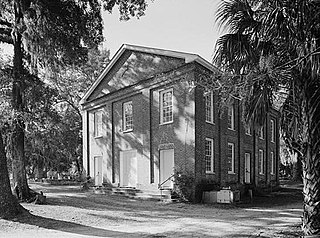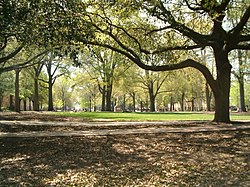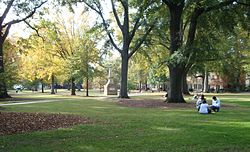
The University of South Carolina is a public research university in Columbia, South Carolina. It has seven satellite campuses throughout the state and its main campus covers over 359 acres (145 ha) in downtown Columbia not far from the South Carolina State House. The university is classified among "R1: Doctoral Universities with Highest Research Activity". It also houses the largest collection of Robert Burns and Scottish literature materials outside Scotland, and the world's largest Ernest Hemingway collection.

The South Carolina State House is the building housing the government of the U.S. state of South Carolina, which includes the South Carolina General Assembly and the offices of the Governor and Lieutenant Governor of South Carolina. Located in the capital city of Columbia near the corner of Gervais and Assembly Streets, the building also housed the Supreme Court until 1971.

Fort Hill, also known as the John C. Calhoun Mansion and Library, is a National Historic Landmark on the Clemson University campus in Clemson, South Carolina. The house is significant as the home from 1825-1850 of John C. Calhoun, the 7th Vice President of the United States, and is now a museum and library maintained in his memory.

Borough House Plantation, also known as Borough House, Hillcrest Plantation and Anderson Place, is an historic plantation on South Carolina Highway 261, 0.8 miles (1.3 km) north of its intersection with U.S. Route 76/US Route 378 in Stateburg, in the High Hills of Santee near Sumter, South Carolina. A National Historic Landmark, the plantation is noted as the largest assemblage of high-style pisé structures in the United States. The main house and six buildings on the plantation were built using this technique, beginning in 1821. The plantation is also notable as the home of Confederate Army General Richard H. Anderson.

The James Petigru Boyce Chapel is a historic church building at 1306 Hampton Street in Columbia, South Carolina. It is a Greek Revival building built in 1859. A convention met here on December 17, 1860, whose delegates voted unanimously for South Carolina to secede from the United States, leading to the American Civil War. It was designated a National Historic Landmark as First Baptist Church, the role it played at the time.

The Chappelle Administration Building, on the campus of Allen University in Columbia, South Carolina, was designed by John Anderson Lankford, known as the "dean of black architects." The building name has been spelled Chapelle Administration Building in HABS and NPS reports. It was declared a National Historic Landmark in 1976, cited as one Lankford's most important works.

The Robert Mills House, also known as Robert Mills Historic House and Park or the Ainsley Hall House, is a historic house museum at 1616 Blanding Street in Columbia, South Carolina. Built in 1823 to a design by Robert Mills, it was designated a National Historic Landmark in 1973 for its architectural significance. The Historic Columbia Foundation owns and operates the home, which has been furnished with decorative arts of the early 19th century, including American Federal, English Regency, and French Empire pieces.

The South Carolina State Hospital is a publicly funded state-run psychiatric hospital in Columbia, South Carolina. Founded in 1821 as the South Carolina Lunatic Asylum, it was one of the first public mental hospitals established in the United States. The Mills Building, its first building, was designed by early American architect Robert Mills, and is a National Historic Landmark. The hospital had more than 1,000 patients in 1900, but with the transition of mental health facilities to community settings, it is now much smaller, occupying a small portion of its campus, with other parts housing offices and facilities of the state's Department of Mental Health.

The Penn Center, formerly the Penn School, is an African-American cultural and educational center in the Corners Community, on Saint Helena Island. Founded in 1862 by Quaker and Unitarian missionaries from Pennsylvania, it was the first school founded in the Southern United States specifically for the education of African-Americans. It provided critical educational facilities to Gullah slaves freed after plantation owners fled the island, and continues to fulfill an educational mission. The campus was designated a National Historic Landmark District in 1974. Darrah Hall and Brick Baptist Church on the campus were declared part of Reconstruction Era National Monument in January 2017. In spring of 2019, it became the Reconstruction Era National Historic Park, along with Fort Sumter.

The Hampton–Preston House located at 1615 Blanding Street in Columbia, South Carolina, is a historic mansion that was the home of members of the prominent Hampton family. It was listed in the National Register of Historic Places on July 29, 1969.

Trinity Episcopal Church, now known as Trinity Episcopal Cathedral, is the first Episcopal and the oldest surviving sanctuary in Columbia, South Carolina. It is a Gothic Revival church that is modeled after York Minster in York, England. It was named to the National Register of Historic Places on February 24, 1971.

Pendleton Historic District in Pendleton, South Carolina is a historic district which is located mostly in Anderson County, South Carolina and partly in Pickens County, South Carolina. The district was listed on the National Register of Historic Places in 1970. The historic district includes the town of Pendleton and its immediate surroundings plus a large tract west towards Lake Hartwell to include the Hopewell Keowee Monument and the Treaty Oak Monument. The entire historic district covers an area of over 6,300 acres (25 km2).

The First Presbyterian Church is a historic church building in Columbia, South Carolina. Constructed in 1854, it was added to the National Register of Historic Places on January 25, 1971.

The Palmetto Building, built during 1912–1913, is an early skyscraper in Columbia, South Carolina. It was designed by architect Julius Harder, and Wilson and Sompayrac served as supervising architects. Upon completion it was the tallest building in South Carolina.

Georgetown Historic District is a national historic district located at Georgetown, Georgetown County, South Carolina. The district encompasses 49 contributing buildings in the central business district of Georgetown. The oldest existing structure in Georgetown is a dwelling which dates from about 1737. There are approximately 28 additional 18th century structures as well as 18 buildings erected during the 19th century prior to the American Civil War. The existing structures—homes, churches, public buildings—are of both historical and architectural significance and are situated on heavily shaded, wide streets. The architecture ranges from the simplicity of early colonial, or Georgian, to the elaborate rice plantation era, such as Classical Revival. Notable buildings include the Georgetown County Courthouse, U.S. Post Office, The Rice Museum, Winyah Indigo Society Hall, Masonic Lodge, Antipedo Baptist Church Cemetery, Prince George Winyah Episcopal Church complex, St. Mary's Catholic Church, Kaminski Building, Mary Man House, Dr. Charles Fyffe / Middleton House, John Cleland / Allston House, Samuel Sampson / Henning-Ward House, Robert Stewart / George Pawley House, Martha Allston Pyatt /John S. Pyatt House, Eleazar Waterman / Withers House, and William Waties / Withers House.

Kensington Plantation House is a historic plantation house located near Eastover, Richland County, South Carolina. It was built between 1851 and 1853, by Colonel Richard Singleton, a brother of Angelica Singleton Van Buren, daughter-in-law of President Martin Van Buren. The wood frame dwelling consists of a 2 1/2-story, central section with a Second Empire style copper covered dome, flanked by lower wings with arched colonnades. The front entrance features a porte-cochere with Corinthian order arches and pilasters.

Debruhl-Marshall House is a historic home located in Columbia, South Carolina. It was built in 1820, and is a two-story, five bay, brick Greek Revival style dwelling. It has a gabled slate roof and full basement. The front facade features a three bay portico supported by four massive Doric order columns.

Columbia Historic District II is a national historic district located at Columbia, South Carolina. The district encompasses 113 contributing buildings and 1 contributing site in a former residential section of Columbia. They were built between the early-19th century and the 1930s and are now mostly used for commercial purposes. The buildings are in the Greek Revival, Gothic Revival, Classical Revival, and the “Columbia Cottage” styles. Notable buildings include the Robert Mills House, Debruhl-Marshall House, Hampton-Preston House, Episcopal Church of the Good Shepherd, Crawford-Clarkson House, Maxcy Gregg House, Hale-Elmore-Seibels House, St. Paul's Lutheran Church, and Ebenezer Lutheran Church.

Winthrop College Historic District is a national historic district located on the campus of Winthrop University at Rock Hill, South Carolina. It encompasses 17 contributing buildings and 1 contributing structure constructed between 1894 and 1943. Architectural styles represented include Gothic Revival, Richardsonian Romanesque, Classical Revival, and Colonial Revival. Notable buildings include the separately listed Tillman Hall and Withers Building, as well as Alumni House, Phelps Dormitory, Thurmond Building, Byrnes Auditorium, Johnson Hall, and the President's Residence.

Allen University Historic District is a historic district in Columbia, South Carolina that includes buildings on the campus of Allen University, originally established as Payne Institute. Buildings in the district include Arnett Hall, the Chappelle Administration Building, Coppin Hall, the Joseph Simon Flippen Library, and the Canteen Building. The district was listed on the National Register of Historic Places April 14,1975. The address is 1530 Harden Street. Originally in a suburb, the university is now near downtown.



























